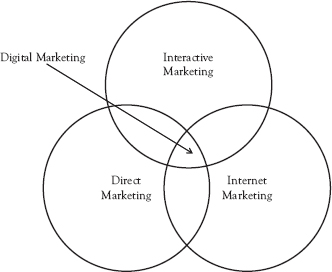This book has covered the major issues related to digital marketing today. Its premise has been the importance of understanding the process of digital marketing. Prior developments in marketing thought and terminology led to the development of digital marketing as a widely used term for using marketing technology to foster interactivity and engagement (Figure 10.1). The company website, e-mail, social media, and search strategies and mobile objectives should all function together. This integration is a hard goal to accomplish if each functional area in the company is working on a different strategy. Certainly education of managers and entry-level employees in this area is important, which is one of the purposes of this book. However, equally important from a management point of view is the education of the executive. It is hoped that the CEO and CMO can read this book and understand better how to move forward to create an organization not only digitally literate but one that can implement the company vision and strategy in this area. CMOs want to be more “data-driven” than intuitive but don’t always know how to get there.96
Figure 10.1 Digital marketing incorporates the best aspects of prior terminology
Maybe even this short book is a little overwhelming to some readers. It will help to do the exercises suggested at the end of each chapter. After doing them, you should be able to launch a more effective digital strategy in any type of firm. I would also suggest to the audience reading this book that the most important aspects of creating an effective digital marketing strategy and managing that strategy effectively would be as follows:
1. Create a clear company strategy around digital marketing and customer data excellence. Communicate that strategy throughout the entire organization.
The research shows that companies that can capitalize on customer information management and other types of digital strategies create a clear mission and vision and communicate that strategy throughout the entire organization. Using the House of Quality for Multichannel Marketing can help create strategies across channels.
2. Start with your website and move outward.
Even in the age of mobile and responsive design, the core website is the key to managing digital marketing within the firm. The website should convey the key message and be a landing destination for customer engagement efforts. Focus from there on the other elements of the digital marketing delivery mix.
3. Develop metrics and key performance indicators (KPIs) around that strategy.
What’s the objective? Are you in prospecting mode, win-back mode, trying to create deeper customer relationships. How will you measure success? Consider the customer lifecycle, the customer acquisition and relationship management continuum, and the basic objectives of attract, acquire, retain, and engage when setting objectives and measures.
4. Reward middle managers and others responsible for implementation.
If there is a disconnection between the company rewards systems and the digital strategy, then results won’t be achieved. Implementation must also take place in customer-facing roles.
5. Make it easy to share data in the organization.
Data “silos” and a lack of data sharing make it difficult to share information and to achieve performance results.
6. Encourage and reward the functional marketing area and their IT counterparts to work together.
Teamwork comes from the corporate vision and setting a clear strategy. This teamwork in turn leads to digital marketing success. Don’t rush into a digital strategy without the underlying structure for success. And don’t overlook processes for data quality, as customer data quality leads to performance.
7. Keep up to date.
Take a look at the articles and websites cited in this book. Many times my students follow the websites and companies recommended in the links in class. There are many good sources of data on digital marketing to keep current. This book provides a structure, but monitoring what is happening in the marketplace will help you stay current.
I will you all good luck in your digital marketing efforts. Please do not hesitate to be in touch with any questions. Join the LinkedIn Group associated with the text to continue the conversation, Digital Marketing Management Handbook at http://linkd.in/1Fn8JUb.
96 Marketing Charts staff. 2014. “US CMOs: Spending on Analytics, Social and Content Growing.” Marketing Charts. http://www.marketingcharts.com/online/us-cmos-spending-on-analytics-social-and-content-growing-44671/ (10/13/2014).

